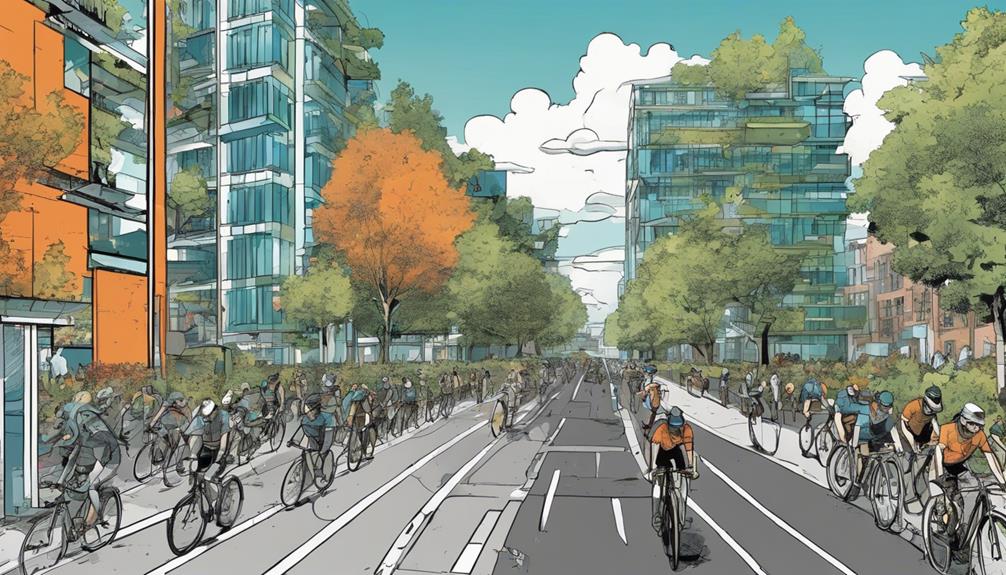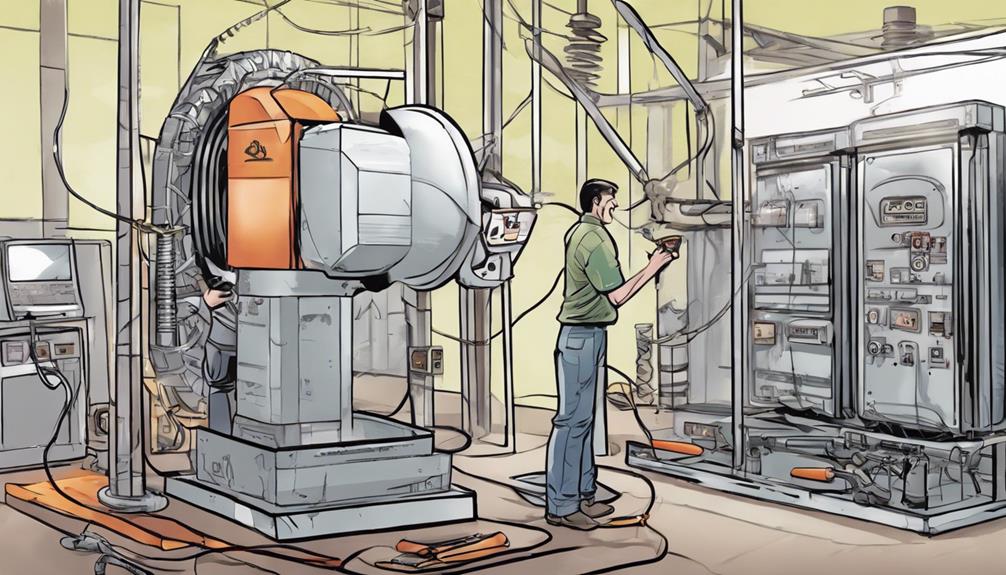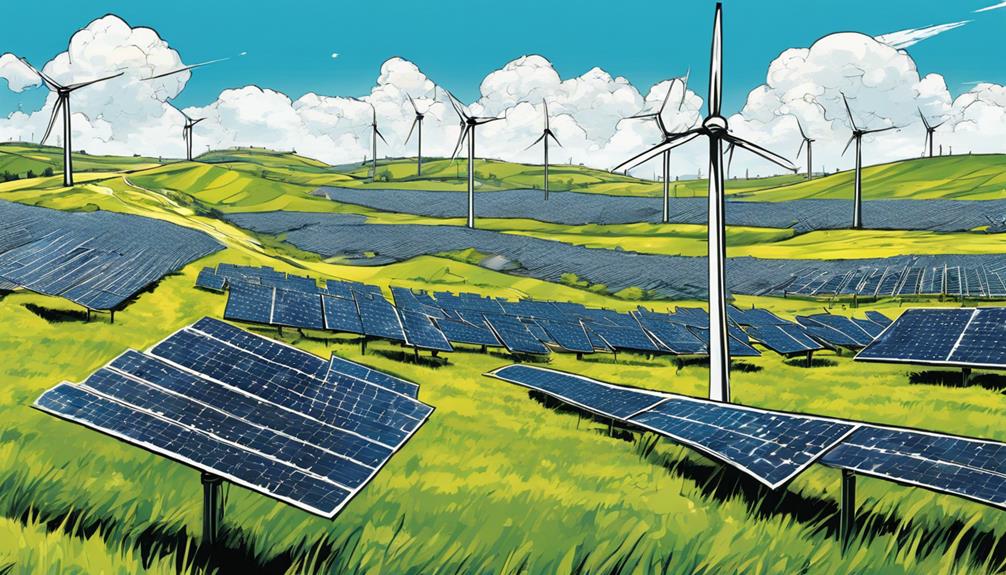You're on the path to discovering how solar energy and bike lanes can transform urban planning. By integrating solar panels into bike lanes, cities can reduce emissions, air pollution, and their reliance on fossil fuels. This innovative approach enhances the nighttime cycling experience, promotes eco-friendly transportation, and supports cleaner e-mobility options. As you explore the intersection of solar energy and bike lanes, you'll uncover the potential for sustainable urban planning to combat climate change and create healthier, more livable cities. The future of urban infrastructure is bright – and you're just getting started.
Key Takeaways
- Solar energy in bike lanes reduces emissions, powers lighting systems, and enhances safety, aligning with sustainable urban planning goals.
- Bioluminescent bike path technology harnesses solar energy during the day to power glowing bike paths at night, promoting eco-friendly transportation.
- Solar-powered bike lanes reduce greenhouse gas emissions, improve air quality, and promote energy independence for electric bikes.
- PLATIO solar pavers support cleaner e-mobility and sustainable transportation, prioritizing safety with a non-slip surface for cyclists.
- Integrating solar energy into bike lanes contributes to a more sustainable future for urban infrastructure, enhancing the overall livability of cities.
Combating Climate Change Effects
As you consider the impact of human activities on the global climate, it's crucial to recognize that sustainable urban development is no longer a choice, but a necessity, with the EU mandating eco-friendly designs in newly constructed buildings to combat climate change.
You're probably aware that climate change is one of the most pressing issues of our time, and it's important to address it through sustainable urban planning. That's where solar energy comes in – a clean and renewable source of power that can greatly reduce our reliance on fossil fuels. By incorporating solar panels into urban planning, you can create a more sustainable and green environment.
Additionally, designing bike lanes and pedestrian-friendly infrastructure can encourage a shift away from carbon-emitting vehicles, further reducing our carbon footprint. As you work towards creating a more sustainable urban space, remember that every small step counts, and it's vital to prioritize green initiatives in your urban planning strategy. By doing so, you'll be contributing to a healthier, more sustainable future for generations to come.
Sustainable Urban Planning Strategies
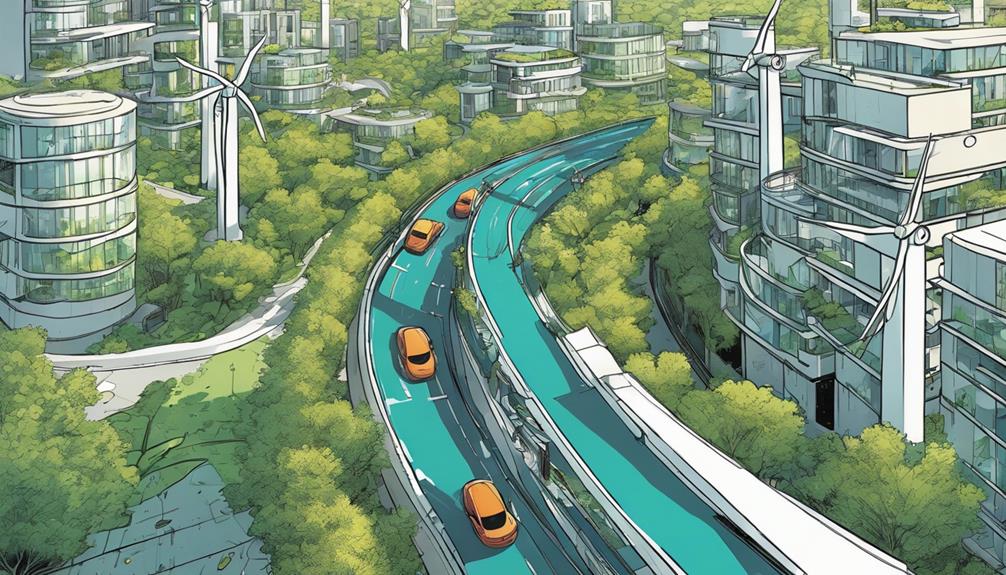
By incorporating solar energy into bike lanes, you can create a sustainable transportation system that not only reduces greenhouse gas emissions but also generates clean energy for urban infrastructure. This innovative approach to sustainable urban planning strategies is a game-changer for eco-friendly transportation.
Solar-powered bike lanes, like PLATIO in Switzerland, have proven successful in generating clean energy for electric bikes and nearby buildings. This not only reduces our reliance on fossil fuels but also improves air quality in urban environments. By integrating solar energy into bike lanes, you're aligning with sustainable urban development goals and promoting a cleaner, more efficient transportation system.
The operational success of PLATIO solar pavement indicates the potential for expansion to other municipalities, making it a viable solution for cities worldwide. As you adopt these sustainable urban planning strategies, you'll be contributing to a cleaner, healthier, and more sustainable future.
Green Building Design Innovations

You're likely familiar with sustainable eco-friendly building designs that incorporate natural landscapes to decrease environmental impact. But did you know that urban planners must also consider affordability, rising costs, and labor shortages when designing these structures?
As you explore the latest eco-friendly building design innovations, you'll discover that alternative energy integration is vital for combating climate change and promoting public health. Sustainable architecture is shifting its focus towards creating healthier communities through design elements that prioritize well-being.
The future of eco-friendly building design lies in integrating alternative energy sources to improve climate resilience and sustainability. By incorporating renewable energy systems, buildings can reduce their carbon footprint and reliance on fossil fuels. This not only benefits the environment but also enhances public health by reducing air pollution.
As you explore further into eco-friendly building design innovations, you'll find that the emphasis is on creating sustainable, climate-resilient structures that support the well-being of occupants while minimizing environmental impact.
Solar Energy for Bike Lanes

As you explore the concept of solar energy for bike lanes, you'll discover innovative ways to integrate solar power into urban infrastructure.
You'll learn how energy harvesting systems can be designed to generate clean energy for various applications, from powering nearby buildings to charging electric bikes.
Solar Power Integration
Innovative bike lanes, like the SolaRoad in the Netherlands, are pioneering the integration of solar power into urban infrastructure by embedding solar panels directly into the path. As you explore this concept, you'll discover how solar power integration is revolutionizing sustainable urban planning. By harnessing clean energy from the sun, these solar cycle paths are reducing carbon emissions and creating a more environmentally friendly transportation system.
You'll find that solar energy collected during the day can power lighting systems along bike lanes, increasing safety at night. Additionally, solar pavers like PLATIO's aren't only slip-resistant but also generate clean energy for electric bikes, making them a game-changer for urban infrastructure.
The operational success of these solar cycle paths demonstrates the feasibility and benefits of integrating solar energy into urban infrastructure for sustainable transportation solutions. By embracing solar power integration, you're contributing to a cleaner, greener, and more sustainable future.
Energy Harvesting Systems
Beyond integrating solar power into urban infrastructure, energy harvesting systems like PLATIO's solar pavers are taking it a step further by generating clean energy for electrical devices directly within bike lanes.
You'll find these innovative solar energy systems embedded in bike lanes, producing renewable energy to power electric devices. The best part? PLATIO solar pavers are designed with safety in mind, featuring a slip-resistant surface to guarantee cyclists can ride with confidence.
In countries like Switzerland, solar-powered cycle paths have already been implemented, charging electric bikes and supporting nearby buildings with excess energy. These solar cycle paths offer an easy-to-install, low-voltage system that functions like conventional pavement while generating renewable energy.
The success of PLATIO solar pavement in Hungary and Switzerland demonstrates its potential to provide renewable energy for cleaner e-mobility and contribute to a greener energy mix.
As you explore the possibilities of energy harvesting systems, you'll discover how they can transform bike lanes into sustainable, eco-friendly transportation hubs. By integrating solar energy systems into bike lanes, cities can take a significant step towards a more sustainable future.
Bioluminescent Bike Path Technology
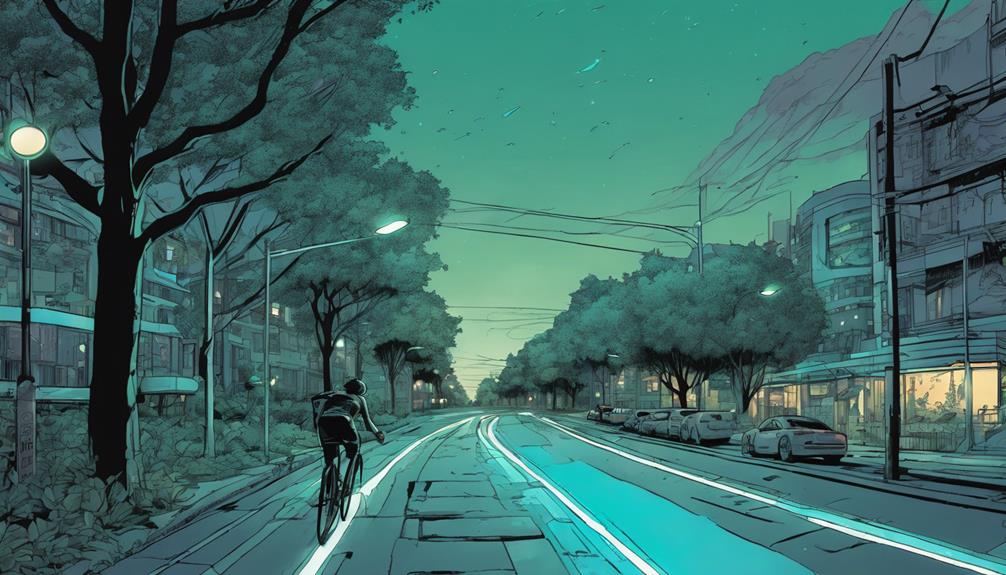
As you explore the world of bioluminescent bike path technology, you'll discover innovative solutions that prioritize safety and sustainability.
You'll learn how glowing bike paths enhance nighttime cycling experiences, and how some paths even harness solar energy to power their illumination.
Glowing Bike Path Safety
With daylight hours diminishing, you're likely to appreciate the safety benefits of Poland's radiant bike path, which harnesses solar energy to illuminate your ride for over 10 hours at night. This innovative bike path uses phosphor technology to collect solar energy during the day, providing a crucial and sustainable solution for urban planning.
As you ride through the night, you'll enjoy the added security of a well-lit path, reducing the risk of accidents and near-misses.
Inspired by Vincent van Gogh's Starry Night, the Netherlands has also introduced a solar-powered radiant bike path in Eindhoven, showcasing the potential for art and technology to merge. These radiant bike paths not only enhance safety but also promote eco-friendly transportation, aligning with the principles of sustainable urban planning.
As cities endeavor to reduce their carbon footprint, innovative solutions like radiant bike paths can play a pivotal role in creating a greener, safer, and more enjoyable urban experience. By embracing bioluminescent bike path technology, cities can revolutionize the way we travel, making our roads safer and more sustainable for generations to come.
Solar Energy Harvesting
You step into the world of bioluminescent bike path technology, where innovative solar energy harvesting solutions are revolutionizing the way we think about urban infrastructure. As you explore this cutting-edge technology, you'll discover how advanced solar panels are being used to harness energy from the sun and power electricity needs.
Here are three exciting examples of solar energy harvesting in action:
- Poland's Glowing Bike Path: This path collects solar energy during the day and glows for over 10 hours at night, providing a safe and sustainable solution for nighttime bike riding.
- The Netherlands' SolaRoad: This innovative road features solar panels on one lane, generating enough energy in six months to power a home for a year.
- Eindhoven's Solar-Powered Bike Path: Inspired by Vincent van Gogh's The Starry Night, this bike path uses solar energy to create a stunning and sustainable nighttime experience.
These examples demonstrate how bioluminescent bike path technology can effectively harness solar energy to meet our electricity needs, reducing our reliance on traditional energy sources and creating a more sustainable future for urban infrastructure.
Nighttime Cycling Experience
Imagine yourself pedaling through a vibrant, glowing bike path on a crisp evening, the stars above mirrored by the luminescent trail beneath your wheels, as bioluminescent bike path technology revolutionizes the nighttime cycling experience.
This innovative technology harnesses solar energy during the day to power a glowing bike path at night, ensuring a safe and enjoyable ride. In Poland, a bioluminescent bike path collects solar energy to glow for over 10 hours, perfect for a nighttime spin. Meanwhile, the Netherlands boasts the Starry Night bike path, inspired by Vincent van Gogh's famous painting, which covers half a mile and has been delighting riders since 2014.
These sustainable urban planning initiatives not only enhance the nighttime cycling experience but also promote eco-friendly transportation solutions. The cost of building such a path, around $31,000, is a worthwhile investment in a sustainable future.
As the world moves towards greener transportation, bioluminescent bike paths are paving the way for a brighter, more environmentally friendly future.
Eco-Friendly Transportation Benefits

By embracing eco-friendly transportation options like solar-powered bike lanes, cities can greatly reduce their carbon footprint and create a healthier environment for residents. You'll not only be contributing to a cleaner environment, but you'll also be promoting sustainable transportation and urban planning.
Here are just a few benefits you can expect from eco-friendly transportation options:
- Reduced greenhouse gas emissions: Solar-powered bike lanes generate clean energy, reducing the need for fossil fuels and decreasing air pollution.
- Improved air quality: By reducing emissions, you'll be improving air quality, which has a direct impact on public health and urban livability.
- Increased energy independence: Solar cycle paths can generate clean energy for electric bikes and devices, reducing reliance on non-renewable energy sources.
Community Engagement in Planning

Effective community engagement in sustainable urban planning involves actively seeking public input to guarantee that diverse perspectives and needs are considered in transportation decisions.
As you participate in planning processes, you'll find that education and awareness campaigns play an essential role in fostering a culture of sustainability, encouraging behavior change towards eco-friendly transportation initiatives.
By engaging with your community, you'll help create more efficient, livable, and sustainable cities.
Sustainable urban planning aims to reduce greenhouse gas emissions, improve air quality, and promote walking, cycling, and public transportation for community well-being.
When you get involved in eco-friendly transportation projects, you're contributing to making cities more resilient, equitable, and thriving through sustainable planning principles.
Your input matters, and inclusive community participation ensures that everyone's voice is heard.
Solar Cycle Path Advantages

You'll be excited to learn that solar cycle paths, like PLATIO in Switzerland, offer a range of advantages that make them an attractive option for sustainable transportation infrastructure. Not only do they charge electric bikes, but they also provide clean energy for nearby buildings, supporting the growth of renewable energy in urban areas.
Here are some key benefits of solar cycle paths:
- Safety first: PLATIO's solar pavers are designed with a non-slip surface, ensuring cyclists can ride safely and confidently.
- Space-saving: Unlike traditional solar panels, solar cycle paths don't reduce pavement space and can be used in the same way as conventional pavement.
- Cleaner e-mobility: Solar cycle paths offer a sustainable solution for generating renewable energy to support cleaner e-mobility options like electric bicycles, aligning perfectly with sustainable urban planning goals.
Urban Planning for Energy Efficiency
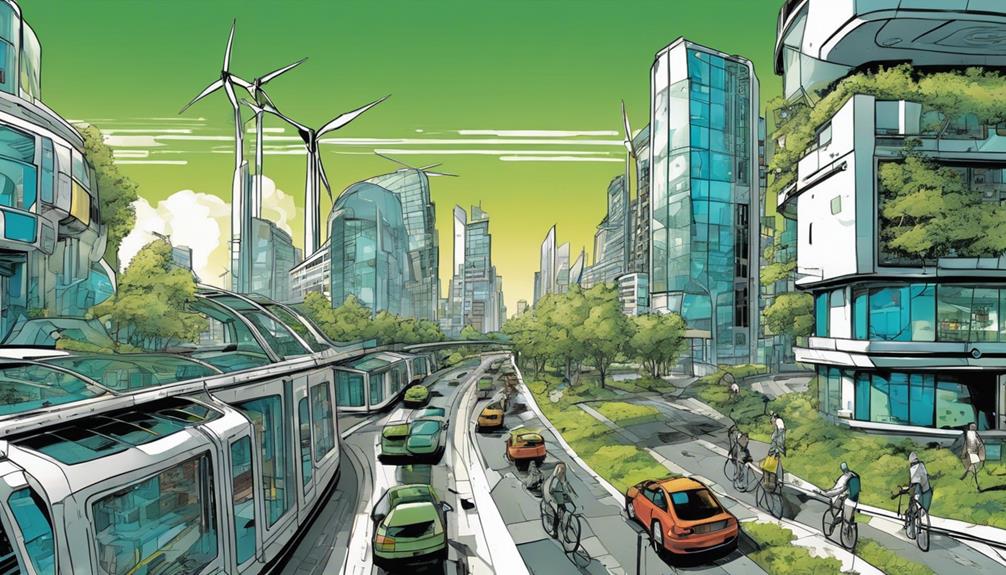
As urban planners work hard to create more sustainable cities, they're turning to innovative solutions like solar bike paths to power infrastructure and reduce carbon emissions.
You'll notice that urban planning for energy efficiency involves incorporating solar energy solutions like these into city infrastructure. The benefits are twofold: not only do solar bike lanes collect solar energy during the day to provide illumination at night, enhancing safety for cyclists, but they also contribute to the city's overall energy efficiency.
Take the Netherlands' SolaRoad, a solar-powered bike path that successfully generates enough energy to power a home for a year. Similarly, PLATIO solar pavers in Switzerland charge electric bikes and support nearby buildings with excess energy.
By integrating solar energy solutions in urban planning, you'll promote sustainability, reduce carbon emissions, and enhance energy security.
As you imagine a future with sustainable cities, you can envision solar bike lanes playing a key role in achieving that vision. With urban planning for energy efficiency, you're one step closer to a cleaner, greener tomorrow.
Environmental Sustainability Solutions

Cities can substantially reduce their environmental footprint by adopting innovative solutions like solar-powered bike lanes. This approach kills two birds with one stone by promoting eco-friendly transportation and generating clean energy. As you explore the possibilities of sustainable urban planning, you'll discover that integrating solar energy into bike lanes is a game-changer for environmental sustainability.
Here are three ways solar-powered bike lanes can make a significant impact:
- Reduce greenhouse gas emissions: By promoting eco-friendly transportation, you'll contribute to a decrease in air pollution and greenhouse gas emissions, creating a healthier environment for you and your community.
- Generate clean energy: Solar energy harvested from bike lanes can power homes, buildings, and even electric bikes, reducing reliance on non-renewable energy sources.
- Enhance safety: Glowing bike paths and solar cycle paths improve safety for nighttime bike riding, making your commute more enjoyable and secure.
Frequently Asked Questions
What Are the Environmental Benefits of Bike Lanes?
You're reducing greenhouse gas emissions and improving air quality when you use bike lanes, which also decrease traffic congestion, making your city a healthier and more sustainable place to live.
Are Bike Lanes a Good Idea?
You're wondering if bike lanes are a good idea? Ha! As if anyone would question the sanity of dedicating a whole lane to, well, you know, saving the planet. But, yes, bike lanes are a great idea, and it's not just about the environmental benefits.
What Is the Purpose of the Bike Lane?
You're wondering what the purpose of bike lanes is? They're designed to promote cycling as a sustainable mode of transport, reducing traffic congestion and improving air quality, while enhancing public health and creating a more livable urban environment for you.
What Is the Introduction of Solar Bicycle?
You're stuck in the dark ages, literally, without solar bicycle paths, which introduce a revolutionary twist – harnessing the sun's energy to light up your ride, making nighttime cycling a whole lot safer and brighter!
How Can Sustainable Business Practices Contribute to Urban Planning for Solar Energy and Bike Lanes?
Sustainable business success is closely linked to urban planning for solar energy and bike lanes. By implementing eco-friendly practices, businesses contribute to reducing carbon emissions and promoting a healthier lifestyle. Supporting the development of solar energy and bike lanes also enhances a community’s environmental sustainability and livability, reinforcing strategies for sustainable business success.
Conclusion
As you gaze out at the concrete jungle, you're faced with a stark reality: cities are hubs of pollution and waste.
But amidst the steel and stone, a glimmer of hope emerges. Imagine pedaling down a bike lane, surrounded by verdant greenery, as solar panels above harness the sun's energy to power the city.
The contrast is jarring, yet exhilarating – a proof of the power of sustainable urban planning.
The future is bright, and it's time to pedal towards a greener tomorrow.
